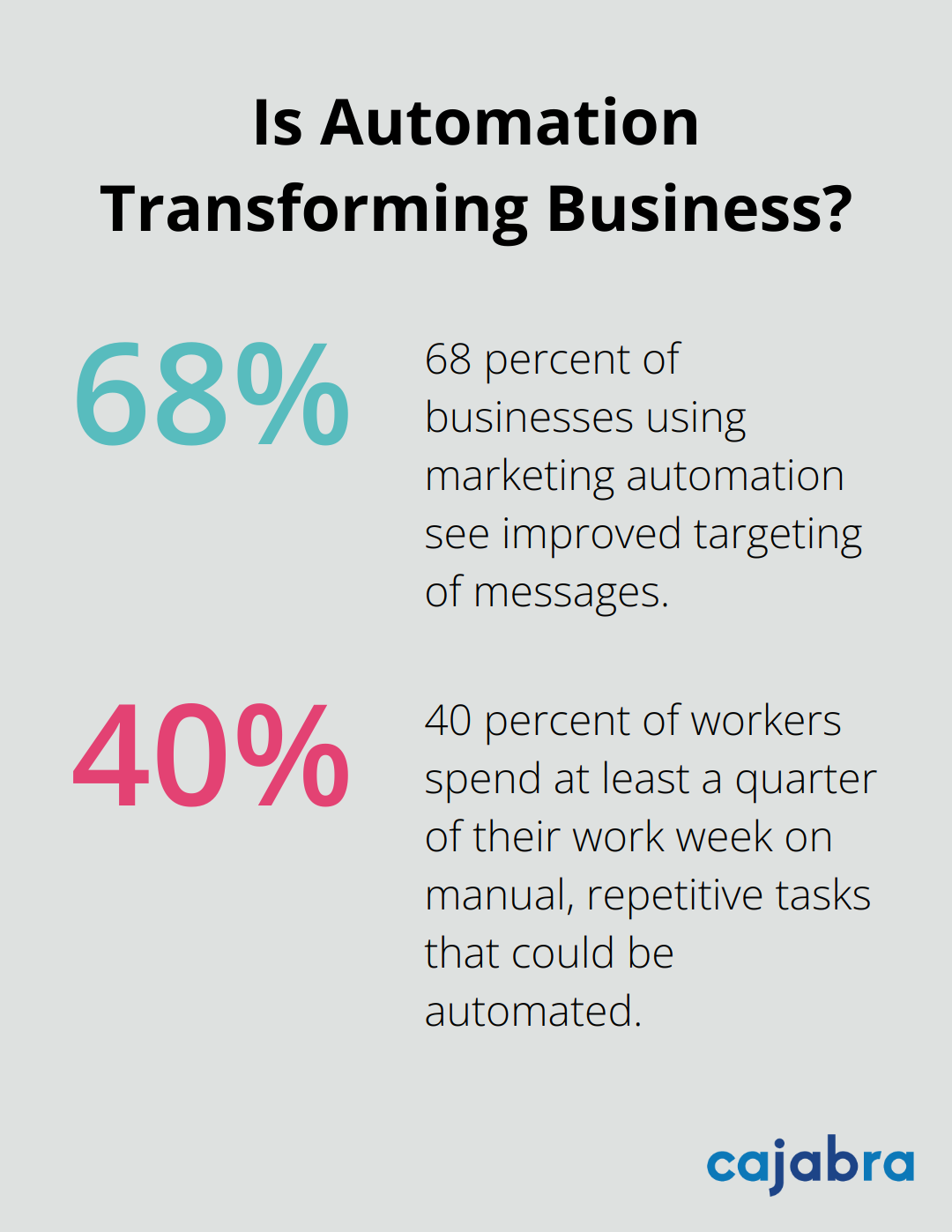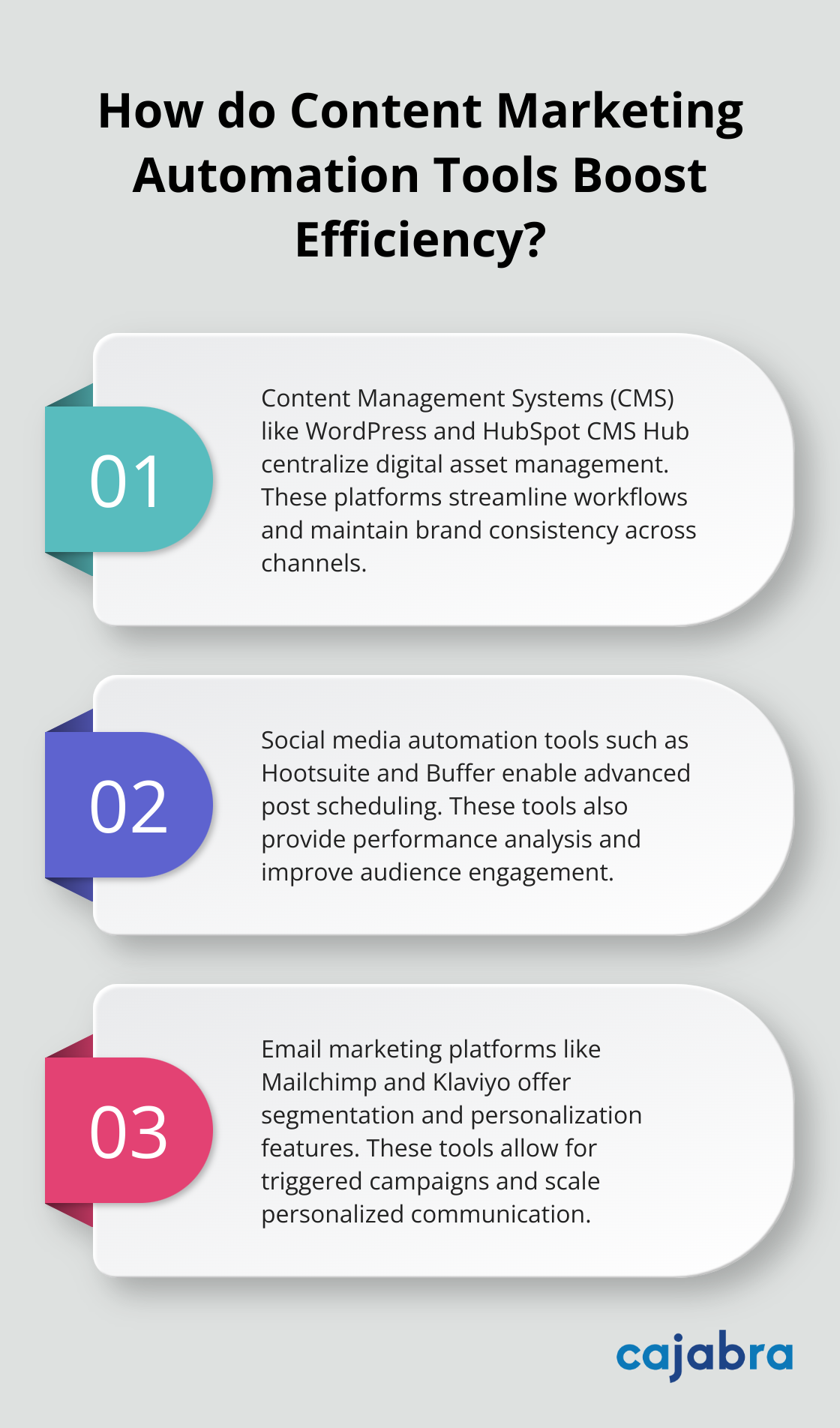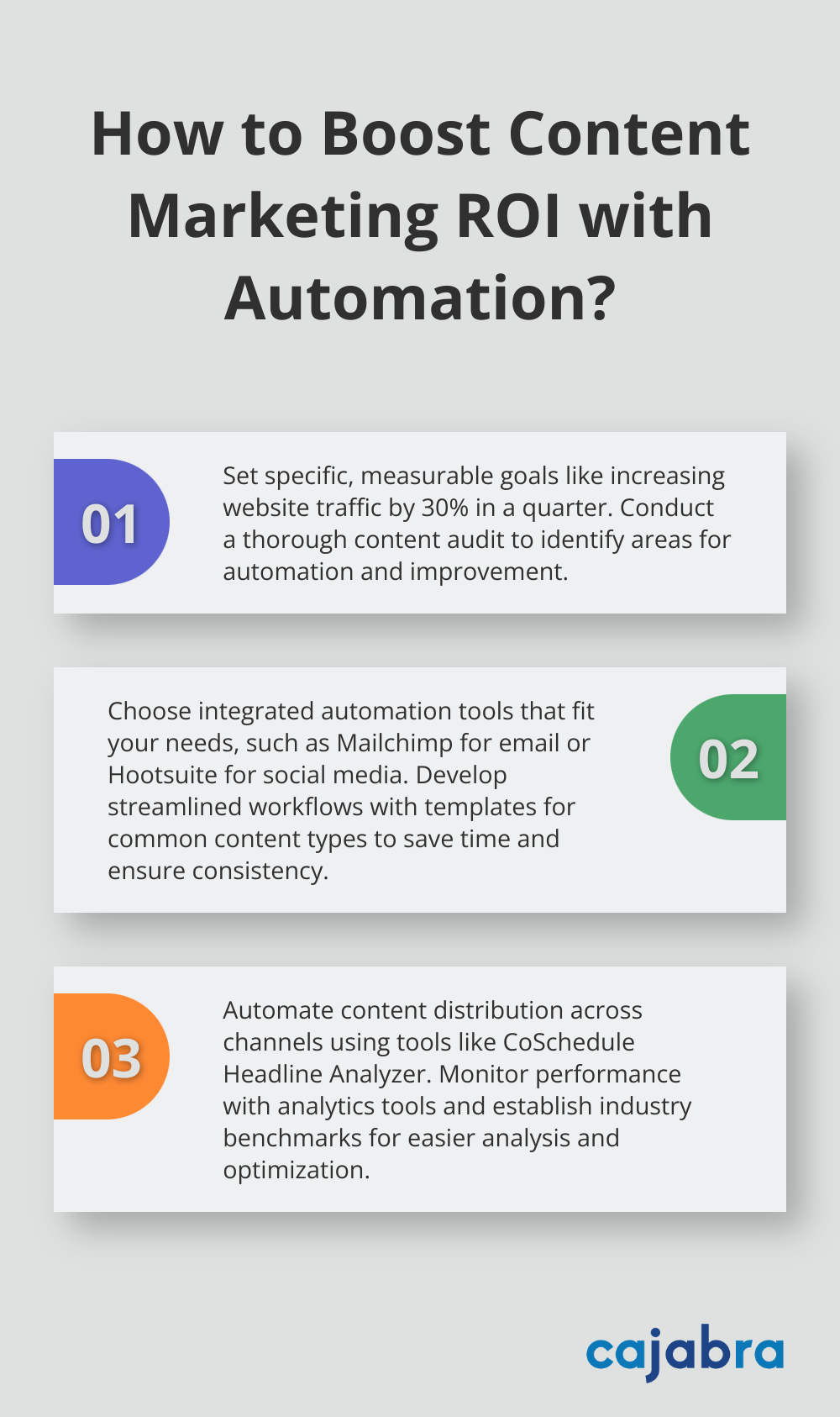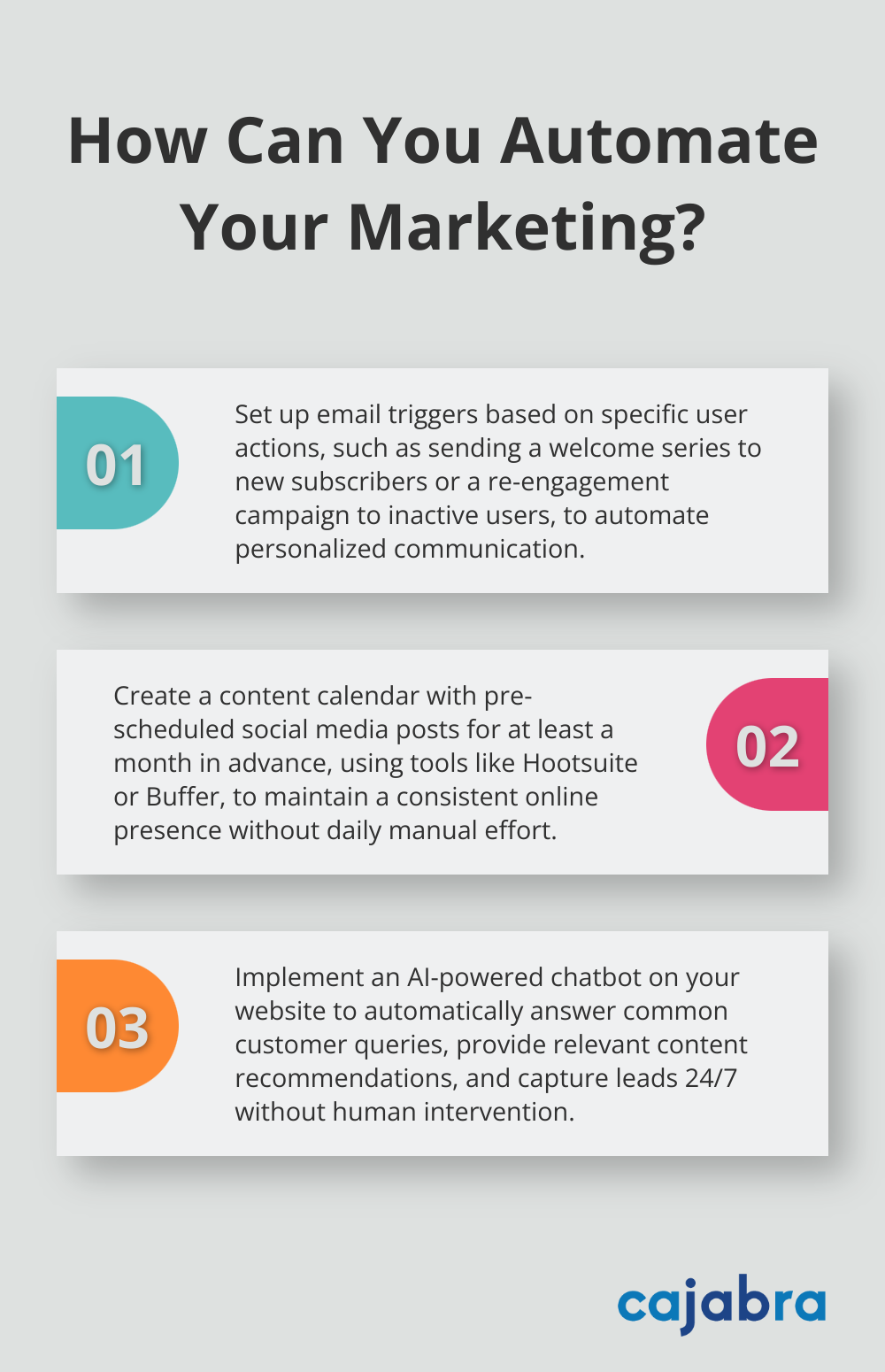
Content marketing is a powerful tool, but it can be time-consuming and resource-intensive. At Cajabra, LLC, we've seen firsthand how automated content marketing can transform businesses.
By leveraging the right tools and strategies, you can streamline your content creation, distribution, and analysis processes. This blog post will guide you through the benefits, tools, and steps to implement an effective automated content marketing strategy.
Content marketing automation revolutionizes business operations. Let's explore the game-changing benefits of this strategy.
Automation frees you to focus on higher-level tasks, slashing time spent on repetitive tasks. A study by Nucleus Research reveals that marketing automation drives a 14.5 percent increase in sales productivity and a 12.2 percent reduction in marketing overhead. This allows teams to focus on high-value activities like strategy development and creative ideation.
Maintaining a consistent brand voice across all platforms builds trust and recognition. Automation tools ensure content adheres to brand guidelines and quality standards. HubSpot reports that 68% of businesses using marketing automation see improved targeting of messages, leading to higher-quality leads and conversions.
Personalization is now an expectation, not a luxury. Automation delivers tailored content to specific audience segments based on behavior, preferences, and demographics. Experian found that personalized emails generate six times higher transaction rates and revenue per email than nonpersonalized email. This level of personalization extends across all marketing channels without manual intervention.
Automated analytics provide real-time insights into content performance. This data empowers quick, informed decisions. Forbes reports that companies adopting data-driven marketing are six times more likely to be profitable year-over-year. Automation tools track key metrics, identify trends, and optimize content strategy on the fly.
Automation simplifies project tracking, task delegation, and timely content publication. This streamlined process (often overlooked in traditional marketing) significantly reduces bottlenecks and improves team collaboration. A study by Smartsheet found that 40% of workers spend at least a quarter of their work week on manual, repetitive tasks that could be automated.

The right automation tools transform your content marketing efforts. They amplify impact, enhance efficiency, and provide valuable insights. As we move forward, let's explore the essential tools and techniques that will elevate your content marketing strategy to new heights.
Content marketing automation transforms business operations with the right tools. This chapter explores the game-changing technologies that will supercharge your strategy.
A robust Content Management System (CMS) forms the backbone of any automated content strategy. Platforms like WordPress, Drupal, or HubSpot CMS Hub offer powerful features for content creation, scheduling, and distribution. These systems allow you to manage all your digital assets in one place, streamline workflows, and maintain brand consistency across channels.

CMS has a favorable impact on marketing efforts by increasing lead generation, improving conversion rates, and providing a more coherent brand presence across channels.
Social media scheduling tools like Hootsuite, Buffer, or Sprout Social maintain a consistent presence across platforms. These tools enable you to plan and schedule posts in advance, analyze performance, and engage with your audience more effectively.
Email remains one of the most effective marketing channels, and automation takes it to the next level. Platforms like Mailchimp, Constant Contact, or Klaviyo offer powerful features for segmentation, personalization, and triggered campaigns.
AI tools revolutionize content creation and optimization. Platforms like GPT-4 Alpha, DALL-E 3, MidJourney, and Stable Diffusion help generate ideas, write drafts, and polish your content. While these tools shouldn't replace human creativity entirely, they can significantly speed up your content production process.
Tools like Google Analytics, SEMrush, or Ahrefs provide invaluable insights into your content's performance. These platforms help you understand your audience, track key metrics, and optimize your strategy based on real data.
The implementation of these tools can dramatically improve your content marketing efficiency and effectiveness. However, it's important to choose the right mix of tools that align with your specific goals and integrate well with your existing systems. (The next chapter will guide you through the steps to implement an automated content marketing strategy effectively.)
Start by defining specific, measurable goals for your content marketing efforts. Do you want to increase website traffic by 30% in the next quarter? Or boost lead generation by 25% in six months? Make sure your objectives align with your overall business goals and track them through concrete KPIs.
Take stock of your existing content and processes before you automate. Analyze which types of content perform best, which channels drive the most engagement, and where bottlenecks occur in your current workflow. This audit will help you identify areas for automation and improvement.
Choose the automation tools that best fit your needs based on your audit and objectives. If email marketing is a priority, consider a platform like Mailchimp or Klaviyo. For social media management, tools like Hootsuite or Buffer could work well. Select tools that integrate seamlessly with each other and your existing systems.
(A word of caution: while many options exist, some businesses struggle with tool overload. Start with a core set of tools and expand as needed.)
Create templates and workflows for your most common content types. This might include email templates for different campaign types, social media post formats for various platforms, or blog post outlines. These templates save time and ensure consistency across your content.

You could set up a workflow where blog posts automatically trigger social media updates and email notifications to subscribers. This approach saves time and ensures a cohesive message across all channels.
Set up systems to automatically distribute your content across various channels. This might involve scheduling social media posts in advance, setting up RSS-to-email campaigns for blog content, or using chatbots to deliver content to website visitors based on their behavior. Consider using content marketing automation tools like CoSchedule Headline Analyzer, SurferSEO Content Editor, or BuzzSumo to streamline your distribution process.
Implement robust analytics tracking to measure the performance of your automated content marketing efforts. Tools like Google Analytics, combined with platform-specific analytics from your CMS or email marketing software, can provide valuable insights.
Review these metrics regularly and use the data to refine your strategy. Establish performance benchmarks for content in your industry to enable easier analysis and comparisons across all your efforts.
To streamline your content process and boost efficiency in your digital marketing efforts, consider creating a content management strategy framework. This can help you maintain consistency and improve the overall effectiveness of your automated content marketing strategy.
Automated content marketing revolutionizes digital strategies, boosting productivity and delivering personalized experiences at scale. Companies reduce time on repetitive tasks, improve targeting, and make data-driven decisions that lead to better results. The future of automated content marketing will likely include more sophisticated AI-powered tools, advanced personalization, and predictive capabilities.

Cajabra understands the power of automated content marketing for accounting firms. Our JAB System™ helps accountants leverage automation to transform their marketing efforts. We enable accounting professionals to focus on their expertise while we handle the complexities of modern digital marketing.
Automated content marketing amplifies your message and reaches your audience more effectively. It frees up time for strategic thinking and creativity, becoming a powerful driver of growth and success for your business. The right approach combines cutting-edge tools with expert strategies to move from overlooked to overbooked in just 90 days.



